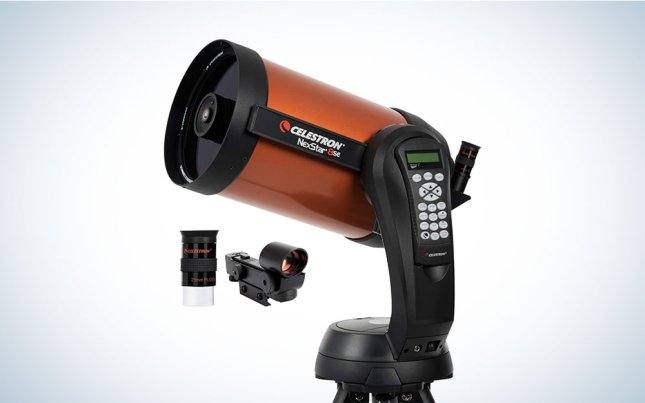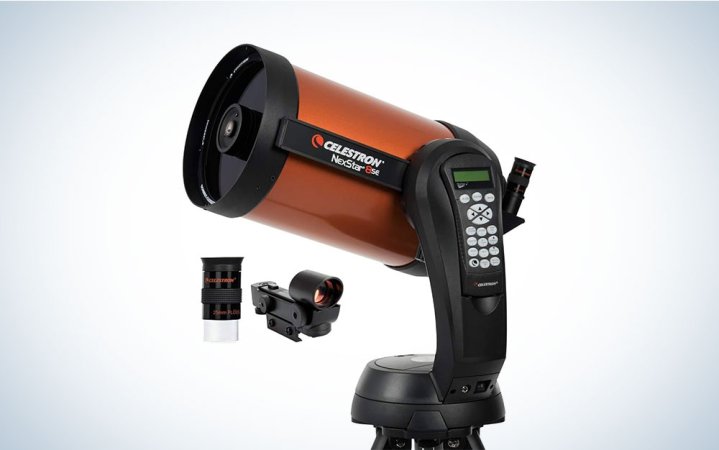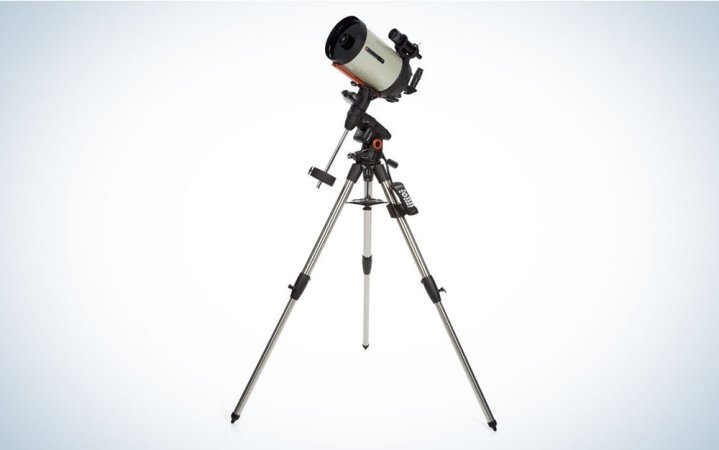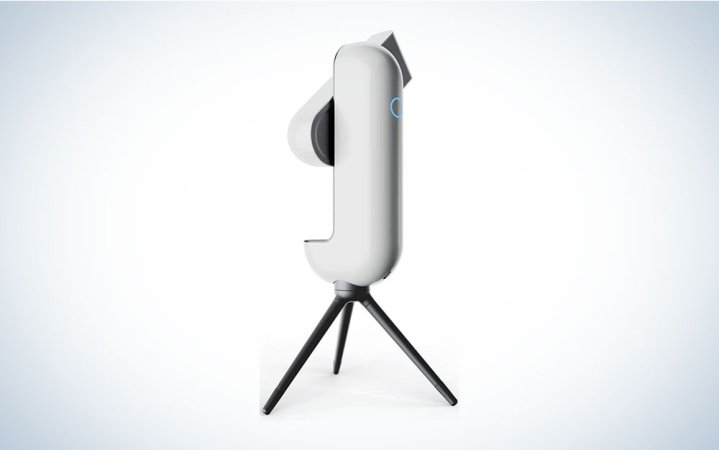We may earn revenue from the products available on this page and participate in affiliate programs. Learn more ›
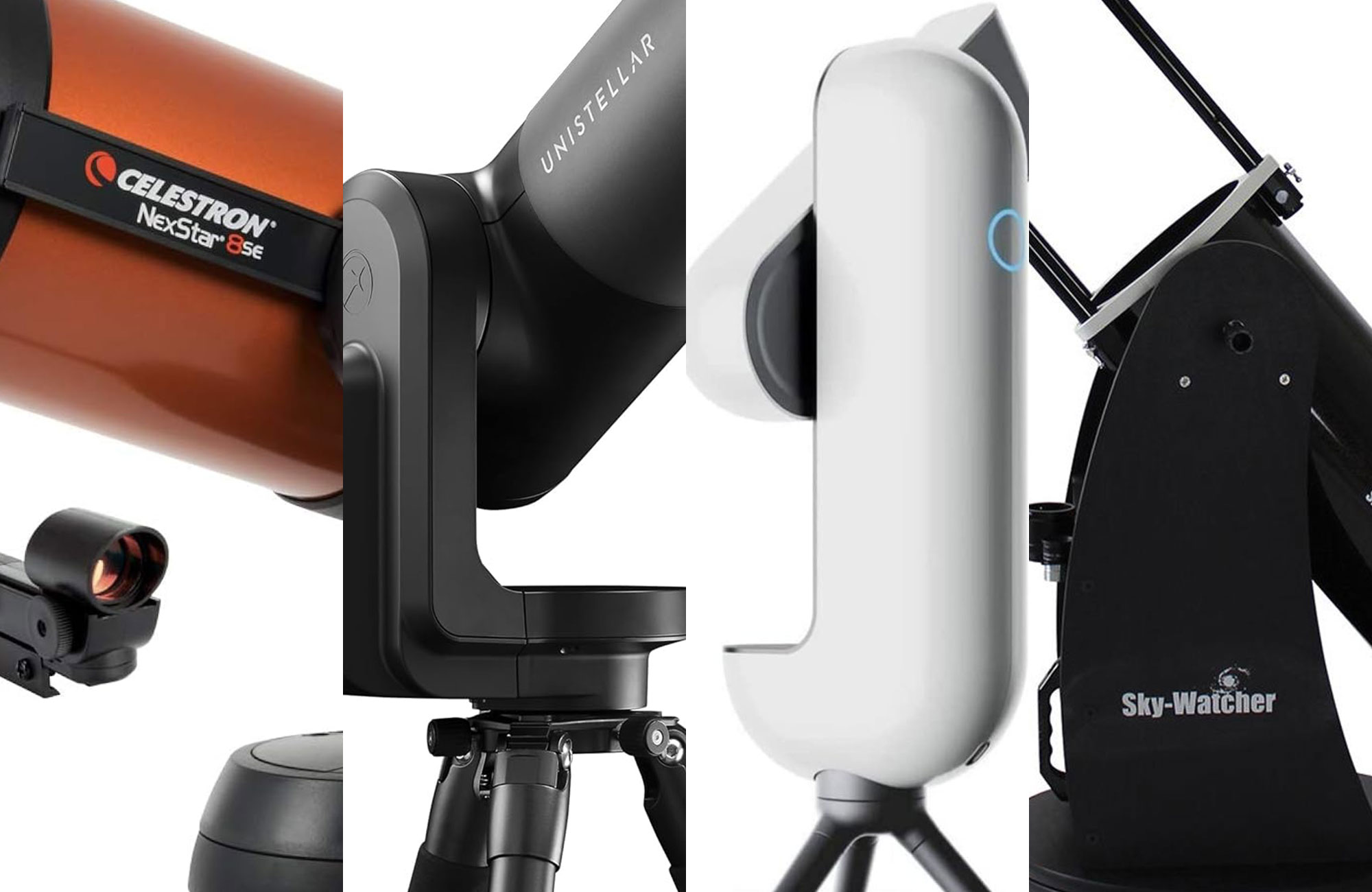
Telescopes for deep space allow you to gaze at the wonders of our universe in a way that wouldn’t be possible with other telescopes. These powerful devices use larger apertures to gather loads of light, illuminating what would be too dim to see otherwise. Many even offer motorized mounts to move to the celestial objects you want to admire automatically. Whether you are a new astronomer or a seasoned pro, the best telescopes for deep space will broaden your horizons.
- Best overall: Celestron NexStar 8SE
- Best smart: Unistellar Equinox 2
- Best splurge: Celestron Advanced VX 8 Edge HD
- Best compact: Vaonis Vespera
- Best budget: Sky-Watcher 8″ Flextube 200P
How we chose the best telescopes for deep space
Telescopes for deep space have more specific requirements than general telescopes. Because of this, we selected powerful scopes with large apertures and plenty of magnification. Beyond those two factors, we also looked for options with and without motorized mounts. Finally, we assessed the quality of the optics, build quality, mount type, and any extra features. We selected based on a mix of hands-on telescope experience, expert insight, editorial reviews, and user feedback.
The best telescopes for deep space: Reviews & Recommendations
If you want to see beyond planets and our moon, you’ll need a telescope for deep space. These powerful scopes will open up the ability to gaze at deep sky objects (DSOs), such as star clusters, nebulas, and galaxies, providing new opportunities for epic stargazing sessions.
Best overall: Celestron NexStar 8SE
Pros
- Computerized mount makes tracking easy
- Very sharp across entire field of view
- Large aperture
- Portable
Cons
- Slewing results in some lag
Specs
- Optical design: Schmidt-Cassegrain
- Mount: Computerized alt-azimuth
- Aperture: 203mm (8 inches)
- Focal length: 2032mm
- Eyepiece: 25mm (81x) Plössl
- Weight: 24 pounds
- Dimensions: 42.01 x 23.66 x 12.99 inches
Our best overall pick comes from one of the most trusted telescope manufacturers. The Celestron NexStar 8SE is a relatively portable Schmidt-Cassegrain scope. It weighs 24 pounds but is quite compact, so you can bring it to dark-sky locations if needed.
This telescope for deep space offers a minimum useful magnification of 29x and a maximum useful magnification of 480x, making it a versatile tool for viewing a wide range of celestial objects, including planets. Plus, the eight-inch aperture captures plenty of light for DSOs. Provided you don’t have much light pollution, you’ll be able to see nebulas, galaxies, and more clearly.
This type of telescope requires collimation, but Celestron’s SkyAlign makes it quick and easy, even for beginners. Another plus for beginners and pros alike is the included alt-azimuth mount, a fully automated Go-To mount. You can select from a database of 40,000 objects, and the telescope will automatically find it and track it across the sky for you. It also comes with a 25mm eyepiece, StarPointer finderscope, visual back, and mirror star diagonal. The NexStar 8SE is pricey, but you get a lot of value for that price that is hard to beat.
Best smart: Unistellar Equinox 2
Pros
- Very easy to use
- Can be used from a distance
- Filters out light pollution
- Portable
- Good battery life
Cons
- Expensive
- Lack of an eyepiece isn’t for everyone
Specs
- Optical design: Newtonian reflector
- Mount: Computerized alt-azimuth
- Aperture: 114mm
- Focal length: 450mm
- Eyepiece: Not applicable (no eyepiece)
- Weight: 19.8 pounds
- Dimensions: 18.6 x 11.2 x 30.4 inches
For those who want to gaze into the heavens from the comfort of their couch, the Unistellar Equinox 2 is the way to go. This smart telescope is unique in that it doesn’t feature an eyepiece. Instead, you pair the scope with the easy-to-use Unistellar app and view from there. This won’t be everyone’s cup of tea, but it makes deep space observation easier for groups and kids. It also came in handy for those mosquito-ridden Florida nights, as my husband and I could stargaze from inside.
The Equinox 2 features a sturdy base with a computerized alt-az mount. After an easy alignment process, you can search a database of 5,000 objects, including DSOs. Then, the telescope will automatically find and track them across the night sky. Or, you can use the in-app joystick to browse on your own.
One of the best features of the Equinox 2 is its Deep Dark Technology, which filters out light pollution. This opens up stargazing even to those living in cities. Though I don’t live in a large city, there is a lot of light pollution, and it was remarkable what I was able to see with this setting turned on. Should you want to travel to dark sky locations, the telescope is relatively compact and portable, and you can even purchase a bundle with a backpack for easier transportation. Want an even more up-to-date (but also more expensive) model? Check out the newly announced Odyssey Pro.
Best splurge: Celestron Advanced VX 8 Edge HD
Pros
- Very compact
- Accurate Go-To mount
- Extremely high-quality optics
- Excellent for both astrophotography and observation
Cons
- Mount isn’t sturdy enough for long-exposure astrophotography
- Expensive
Specs
- Optical design: Schmidt-Cassegrain
- Mount: Computerized equatorial mount
- Aperture: 203mm (8 inches)
- Focal length: 2032mm
- Eyepiece: 12mm (150x) and 40mm (38x)
- Weight: 61 pounds (full kit)
- Dimensions: 9.1 x 9.1 x 9.1 inches
Our splurge pick is also one of the best telescopes for astrophotography. It features high-quality optics that fully correct for coma and field curvature, resulting in a truly flat field. Plus, the StarBright XLT coatings provide better light transmission for bright, sharp images.
The included equatorial mount makes tracking objects easy, so you can make long observations or take long-exposure photos. It is computerized with Go-To functionality, making it easy to find and automatically track objects of interest. The mount even features ports for hand control, an autoguider, and two AUX ports for optional accessories. All those ports make it an ideal option for seasoned pros or for beginners who want something to grow into.
Adding to the versatility of this scop is the ability to use three different f-stop configurations. You can attach a camera to the scope for f/10 or attach the eight-inch EdgeHD focal reducer to shoot at f/7. Finally, the EdgeHD is Fastar/Hyperstar compatible, making it possible to shoot at f/2. It is also quite compact, albeit fairly heavy, making it feasible to travel with. This is an expensive telescope for deep space, but you won’t be disappointed if you want something to last a long time or are looking for extremely high-quality optics.
Best compact: Vaonis Vespera
Pros
- Very compact and portable
- Helps remove light pollution
- Sleek, futuristic design
- Ideal for group observations
Cons
- Images aren’t very high-quality
Specs
- Optical design: Apochromatic (APO) quadruplet refractor
- Mount: Computerized alt-azimuth
- Aperture: 50mm (2 inches)
- Focal length: 200mm
- Eyepiece: Not applicable
- Weight: 11 pounds
- Dimensions: 15 x 8 x 3.5 inches
The Vaonis Vespera is one of the best options If you love to travel and want a telescope for deep space to take along. Weighing only 11 pounds and measuring 15 by 8 by 3.5 inches, the Vespera is very compact for what it provides. It also features a futuristic design, which will look nice sitting in your home.
Like the Unistellar telescope, this option doesn’t offer an eyepiece. It can pair with up to five smartphones or tablets via the Singularity app, making it a fun way to stargaze with friends. Also like the Unistellar, it can filter out light pollution so that you can view DSOs even in cities. The telescope and app are both easy to use, so you’ll have no issues if you are a complete novice.
The Vespera uses a Sony IMX462 image sensor to produce images. Unfortunately, this isn’t a great option if you want high-quality images of celestial objects. It only offers a resolution of 1920 by 1080 pixels, and users report that images are a little on the soft side. But it uses your phone’s GPS to calibrate yourself and automatically tracks objects, taking the work out of stargazing.
Best budget: Sky-Watcher 8″ Flextube 200P
Pros
- Included mount is very sturdy
- Very large aperture for the price
- Comes with two eyepieces and an eyepiece tray
- Smooth movements for manual tracking
Cons
- Not motorized Go-To functionality
Specs
- Optical design: Newtonian reflector
- Mount: Dobsonian
- Aperture: 203mm (8 inches)
- Focal length: 1200mm
- Eyepiece: 10mm (120x) and 25mm (48x)
- Weight: 52 pounds (full kit)
- Dimensions: Base: 29.5 x 20 inches
Telescopes for deep space are not cheap; there’s no getting around it. But the Sky-Watcher 8” Flextube 200P offers a much more budget-friendly option for deep sky observation. Coming in well below $1,000 when writing, this device provides a large eight-inch aperture for plenty of light gathering.
The Flextube 200P comes with two eyepieces, offering more versatility. It also includes an eyepiece tray to keep your accessories organized. The 1200mm focal length offers plenty of reach for deep space viewing, with a maximum useful magnification of 400x. The high-quality mount allows for smooth movements as you scan the sky.
This is not a lightweight device at 52 pounds (the base and scope combined). But it is relatively compact so that it will fit well in smaller spaces. Should you need to transport the scope, it comes apart in two pieces to make it easier. The Flextube 200P also doesn’t feature a motorized mount, meaning it requires manual input for finding and tracking objects. Purists will appreciate that, but it may take some getting used to for novices. It comes with a 50mm finder, though, which makes it easier to find what you are after.
What to consider when buying the best telescopes for deep space
Telescopes for deep space have some specific requirements beyond most scopes. Add to that all the highly technical jargon that goes along with telescopes, and it can be extremely confusing what to actually pay attention to when shopping. Below are some key features you’ll need to consider when choosing your new telescope to look out at the cosmos’ wonders.
Aperture
The aperture is the most important aspect of a telescope for deep space (yes, this is even more important than magnification). A telescope’s aperture controls how much light is let in. It is measured in millimeters or inches. If you want to check out deep-space objects, you’ll need a telescope with a large aperture to gather as much light as possible. Broadly speaking, your best bet is to choose the largest aperture you can afford.
The exact type of object you want to check out could also guide your decision. Celestron suggests a minimum of 5 inches (120mm) for open star clusters and at least 8-11 inches (200-280 mm) for galaxies.
Focal length & magnification
The focal length of your telescope is a measurement (measured in millimeters) of the distance between the primary lens or mirror and where the light comes in to focus at the other end. Focal length matters because it is part of what determines its magnification.
While it might be somewhat counterintuitive, you don’t need crazy high magnification to view deep-space objects (DSOs). In fact, too much magnification may prevent you from seeing the object in the best light. Depending on what exactly you hope to check out, a focal length of 800 to 1250mm or so is best.
Eyepiece
The other piece of the magnification puzzle is the eyepiece. Most telescopes will come with two eyepieces, providing different levels of magnification for better versatility. You can also purchase eyepieces separately if you want more options.
Keep in mind that each telescope will have a minimum and maximum useful magnification. If you choose an eyepiece with too much magnification for your telescope, you will see objects larger, but it won’t be any sharper, so you may not get a very clear image. On the other hand, if you go with too little magnification, there will be a vignette around your view, and you won’t see the entire field of view.
Without getting too into the weeds, there are also multiple types of eyepieces, each with its pros and cons. The most common ones that you’ll find are Barlow and Plössl eyepieces. Barlow lenses feature optical elements that increase magnification by either twice or triple as you step up. Plössl eyepieces offer a wider field of view, which makes them ideal for deep sky viewing.
Optical design
There are many types of telescopes, but broadly speaking, there are three categories for consumers: Refractor, reflector, and catadioptric.
Refractor telescopes use lenses (typically made of glass) to allow the light to travel in a straight path from the front objective lens to the eyepiece at the back of the telescope. These are easy to use, reliable, and require little to no maintenance. However, if you want a large aperture, they are quite long. They also get expensive, especially for high-quality refractors, since the glass lenses are pricey to produce well.
Reflector telescopes, including Newtonian and Dobsonian types, use mirrors to bounce light inside the device, allowing for a shorter design than refractor scopes. Mirrors are cheaper to make than glass lenses, so reflector telescopes are generally more affordable when compared to the same aperture as refractor scopes. They can, however, be quite bulky and heavy and need to be collimated (the process of aligning the mirrors), which adds a step before you can use your scope.
Finally, catadioptric telescopes use both mirrors and lenses, allowing for a compact, portable design. Schmidt-Cassegrains and Maksutov-Cassegrains are two types of catadioptric telescopes that you’ll encounter.
Mount type
The type of mount your telescope uses will impact how you can use it. At the risk of sounding like a broken record, there are three primary types you’ll encounter: Dobsonian, alt-azimuth, and equatorial.
Alt-azimuth mounts (also called alt-az) are the simplest and, therefore, most affordable. They allow for altitude (vertical) and azimuth (horizontal) adjustments. High-quality alt-az mounts also provide smooth tracking abilities; some even feature a motor for automated tracking.
Dobsonian mounts use a platform much like a lazy susan. As a result, they need to be placed on sturdy, flat surfaces, such as a table. They provide excellent stability, as long as you have a good place to put it. They are not very portable, though, so these are best suited for homes where you can set it up and leave it.
Finally, equatorial mounts counteract the Earth’s rotation, allowing you to focus on a single object and track it across the night sky. As a result, they are the preferred choice for serious astrophotography and long observations of single celestial objects.
FAQs
The most important feature of a telescope for deep space observation is the aperture of the objective lens. Large apertures collect more light, necessary for faint objects far away. You’ll also need a sturdy mount to keep the telescope still throughout your viewing. If you want to view a single object for long periods, you’ll want to go with an equatorial mount or a smart telescope that can track automatically for you.
You can absolutely buy used telescopes. Most telescopes require little maintenance, so purchasing a used one is typically a safe bet. It can save you a lot of money, allowing you to get into star gazing for less while reducing your impact on the environment in at least a small way.
Telescopes for deep space allow you to see beyond our solar system. These are typically called deep space objects, or DSOs, and include galaxies, nebulae, and star clusters. Keep in mind, however, that in order to view deep-space objects, you’ll need extremely dark skies. Light pollution of any almost level can prevent you from seeing distant objects.
Final thoughts on the best telescopes for deep space
- Best overall: Celestron NexStar 8SE
- Best smart: Unistellar Equinox 2
- Best splurge: Celestron Advanced VX 8 Edge HD
- Best compact: Vaonis Vespera
- Best budget: Sky-Watcher 8″ Flextube 200P
Telescopes for deep space have specific requirements that make them more expensive than basic scopes. But, if there’s room in your budget, they allow for epic stargazing, opening up new discoveries. And although they may be more advanced than cheap telescopes, most are still very beginner-friendly.
